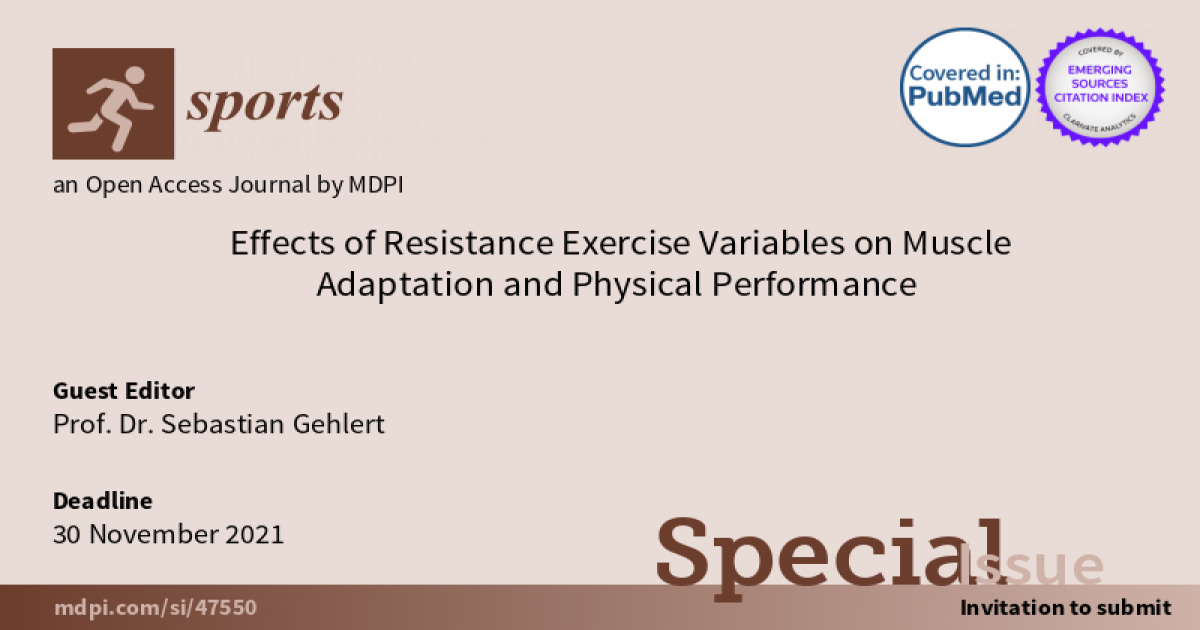- 2.9Impact Factor
- 4.1CiteScore
- 19 daysTime to First Decision
Effects of Resistance Exercise Variables on Muscle Adaptation and Physical Performance
Special Issue Information
Dear Colleagues,
Skeletal muscle is a prerequisite for directed movement of humans and physical performance in sports. Due to its ability to adapt to a wide range of mechanical and metabolic stimuli, exercise provides the fundamental basis for performance enhancement. Resistance exercise is a highly potent method to increase skeletal muscle mass and force generation in humans, a key factor for performance in many disciplines. Research in recent decades has generated a profound knowledge of molecular mechanisms that explain skeletal muscle adaptation towards resistance exercise. Major mechanisms that maintain skeletal muscle proteostasis in mechanically loaded human skeletal muscle, involve molecular networks that control synthesis and degradation of functional proteins within myofibers. However, it is of crucial importance for the athlete and the coach to estimate the effect of varying intensities, volumes, and modes of muscle contractions by resistance exercise on the outcome of myofiber adaptations and resulting muscle performance. For this Special Issue, we encourage international groups of muscle researchers, exercise physiologists, and sports scientists to submit papers that cover the interface between resistance exercise variables and biological muscle adaptations with a link to muscle or exercise performance. The Special Issue aims to further bridge the gap between theory and praxis of muscle adaptation in relation to performance enhancement in sports.
Prof. Dr. Sebastian Gehlert
Guest Editor
Manuscript Submission Information
Manuscripts should be submitted online at www.mdpi.com by registering and logging in to this website. Once you are registered, click here to go to the submission form. Manuscripts can be submitted until the deadline. All submissions that pass pre-check are peer-reviewed. Accepted papers will be published continuously in the journal (as soon as accepted) and will be listed together on the special issue website. Research articles, review articles as well as short communications are invited. For planned papers, a title and short abstract (about 250 words) can be sent to the Editorial Office for assessment.
Submitted manuscripts should not have been published previously, nor be under consideration for publication elsewhere (except conference proceedings papers). All manuscripts are thoroughly refereed through a single-blind peer-review process. A guide for authors and other relevant information for submission of manuscripts is available on the Instructions for Authors page. Sports is an international peer-reviewed open access monthly journal published by MDPI.
Please visit the Instructions for Authors page before submitting a manuscript. The Article Processing Charge (APC) for publication in this open access journal is 1800 CHF (Swiss Francs). Submitted papers should be well formatted and use good English. Authors may use MDPI's English editing service prior to publication or during author revisions.
Keywords
- Skeletal muscle adaptation
- Cellular adaptation
- Resistance training variables
- Molecular adaptation
- Protein synthesis
- Protein degradation
- Muscle fibers
- Force generation
- Strength performance
- Skeletal muscle growth

Benefits of Publishing in a Special Issue
- Ease of navigation: Grouping papers by topic helps scholars navigate broad scope journals more efficiently.
- Greater discoverability: Special Issues support the reach and impact of scientific research. Articles in Special Issues are more discoverable and cited more frequently.
- Expansion of research network: Special Issues facilitate connections among authors, fostering scientific collaborations.
- External promotion: Articles in Special Issues are often promoted through the journal's social media, increasing their visibility.
- e-Book format: Special Issues with more than 10 articles can be published as dedicated e-books, ensuring wide and rapid dissemination.

